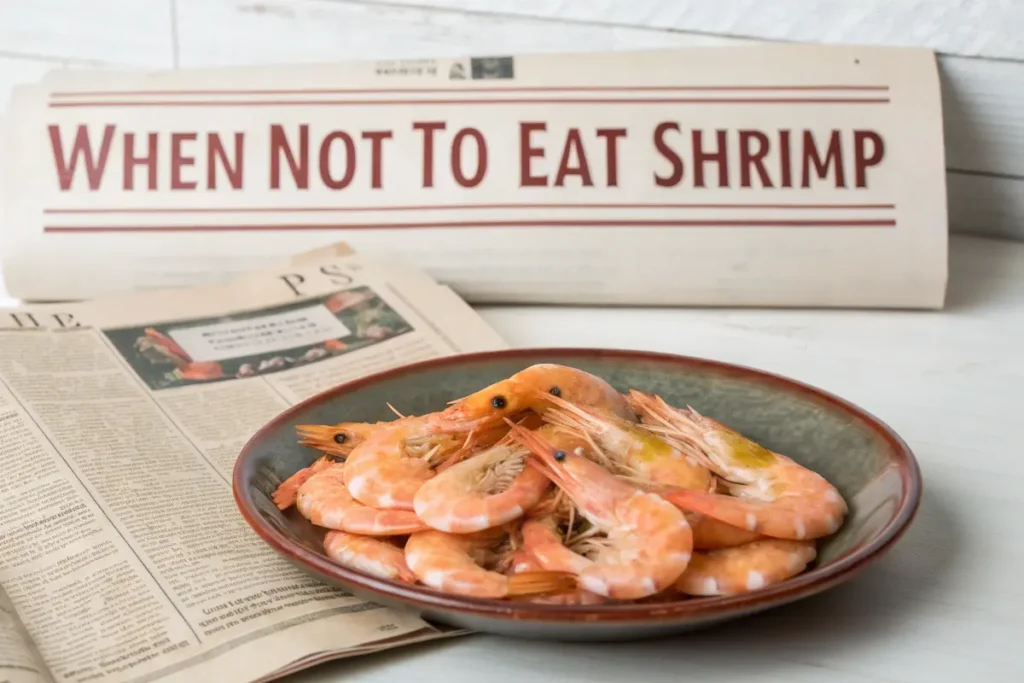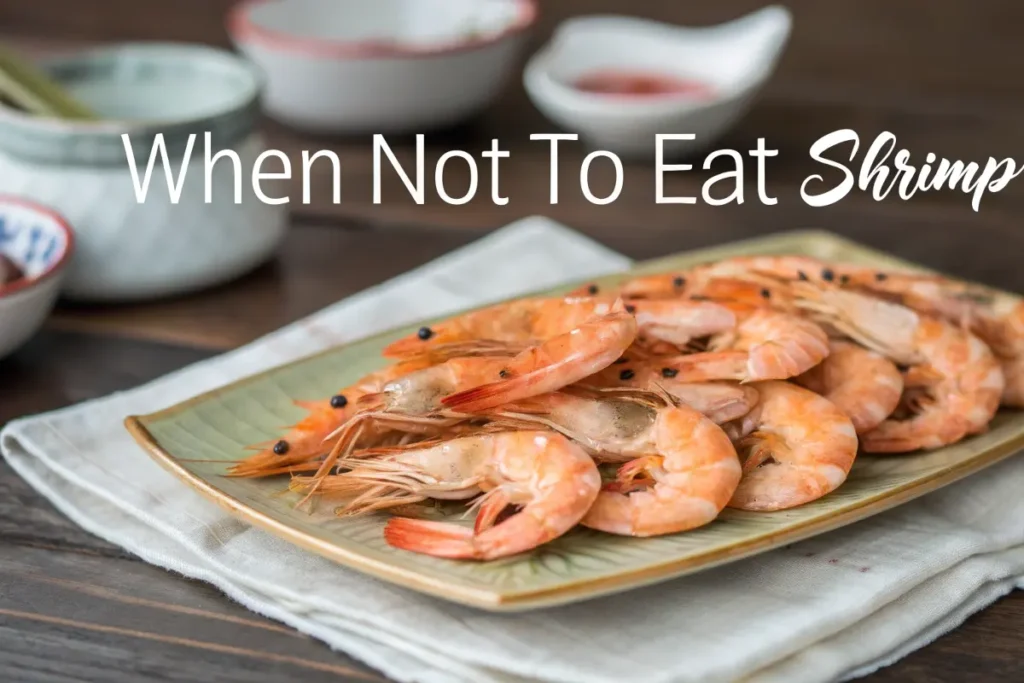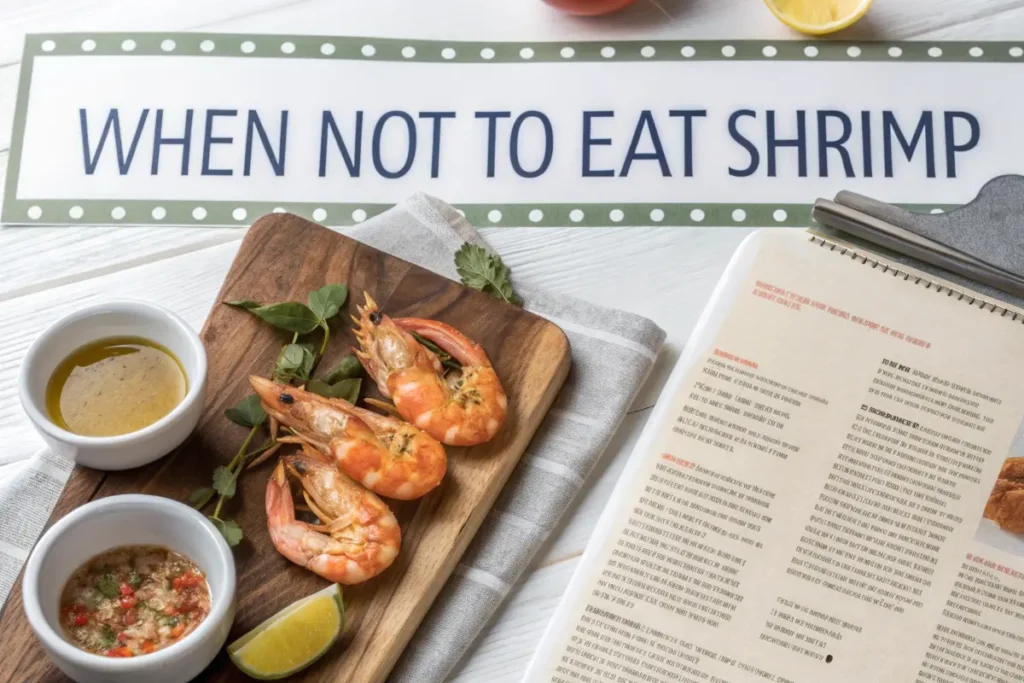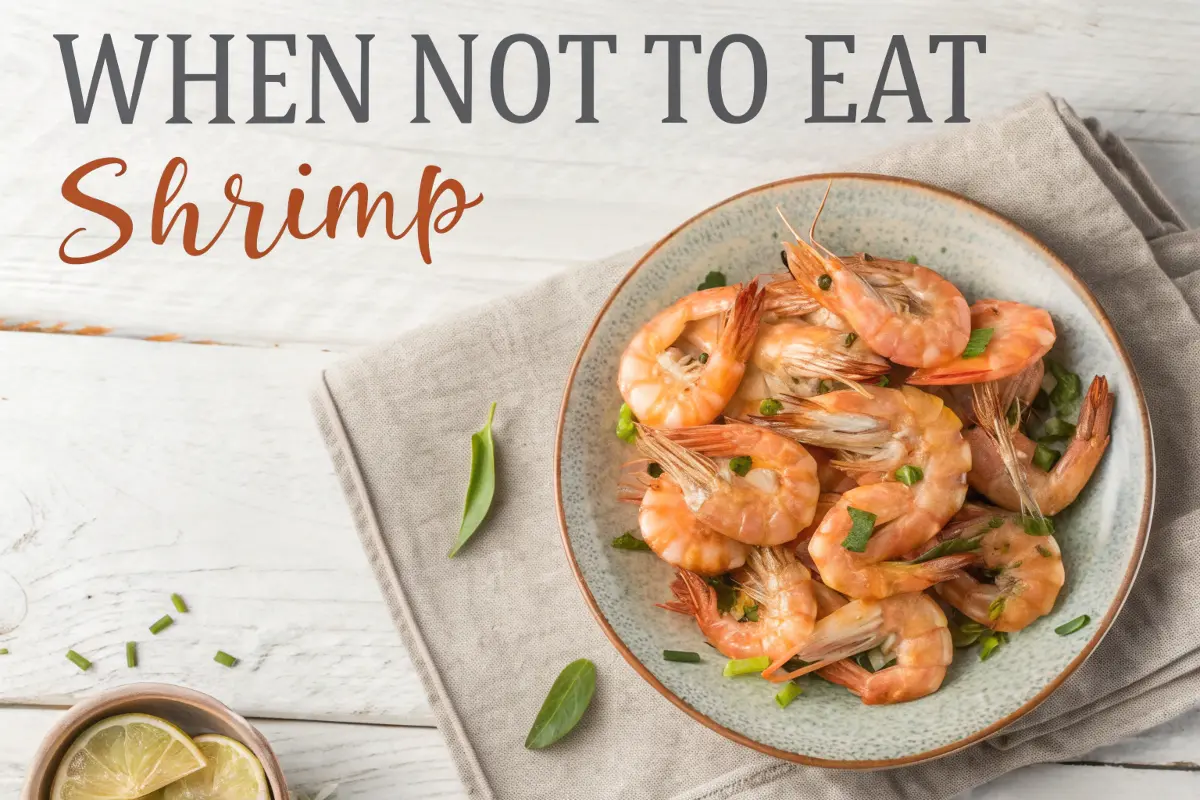Shrimp is a popular seafood loved for its versatility in various dishes, but it’s important to know when it’s not advisable to indulge in this tasty treat. While shrimp is often a healthy source of protein, omega-3 fatty acids, and other nutrients, there are specific situations where eating shrimp might not be the best choice for your health. In this article, we’ll dive into the factors to consider when deciding when not to eat shrimp, as well as provide guidance on making the safest choices for you and your loved ones.
Health Concerns: When Shrimp May Not Be Safe
Although shrimp is generally safe for consumption, there are certain health concerns that might make it risky for some individuals to eat. It’s essential to understand these risks before incorporating shrimp into your diet.
Allergies to Shrimp
One of the most common health concerns associated with shrimp consumption is an allergy. Shrimp allergy can cause severe reactions in some individuals, ranging from mild rashes to anaphylaxis, which can be life-threatening. If you’ve ever had a known reaction to shrimp or other shellfish, it’s crucial to avoid it entirely.
- Symptoms: Hives, swelling, difficulty breathing, and dizziness are common allergic reactions to shrimp.
- Cross-Contamination: Even small traces of shrimp can cause allergic reactions. If you have a shrimp allergy, always ensure your food is prepared in an allergy-safe environment.
Cholesterol Levels and Heart Health
Shrimp is relatively high in cholesterol. While it’s a source of lean protein, the cholesterol content might be a concern for individuals with high cholesterol or those at risk of heart disease. Research shows that dietary cholesterol has less of an impact on blood cholesterol than previously thought, but moderation is still important.
- Recommendation: If you’re managing high cholesterol or cardiovascular issues, consider limiting shrimp intake or consult with your healthcare provider for advice tailored to your health needs.
Environmental Concerns: Shrimp Farming and Sustainability
Environmental sustainability is a key consideration when deciding when not to eat shrimp. Unfortunately, not all shrimp comes from sustainable sources, and some farming practices can be harmful to marine ecosystems.
Impact of Shrimp Farming
Commercial shrimp farming has been criticized for its negative environmental impact, including habitat destruction, water pollution, and the use of harmful chemicals. Shrimp farms often operate in coastal areas, leading to mangrove deforestation, which is essential for protecting coastal ecosystems.
- Sustainable Shrimp: To minimize your environmental footprint, choose shrimp that is farmed sustainably or harvested from wild fisheries that follow responsible practices.
Shrimp Sourcing Certifications
When purchasing shrimp, look for certifications such as the Aquaculture Stewardship Council (ASC) or the Marine Stewardship Council (MSC), which indicate that the shrimp was sourced responsibly. This ensures that the farming or harvesting process was done with minimal environmental impact.

Risk of Contamination: Shrimp and Food Safety
Contamination is another critical factor to consider when deciding when not to eat shrimp. Like all seafood, shrimp can harbor bacteria, viruses, and toxins that pose health risks if not properly handled or cooked.
Bacterial Contamination
Raw or undercooked shrimp is often contaminated with bacteria such as Vibrio species, which can cause severe gastrointestinal issues. These bacteria thrive in warm waters, and shrimp harvested from these areas may carry the pathogens.
- Safe Cooking: Always cook shrimp thoroughly to eliminate the risk of bacterial contamination. Shrimp should be cooked to an internal temperature of 145°F (63°C), turning pink and opaque.
Toxins and Heavy Metals
Some shrimp, especially those sourced from polluted waters, can contain harmful levels of toxins or heavy metals, such as mercury. High levels of mercury can be detrimental to your health, particularly for pregnant women and young children.
- Tip: If you’re concerned about mercury, choose smaller shrimp varieties, as they tend to accumulate fewer toxins than larger ones.
The Risks of Overconsumption: Moderation Is Key
While shrimp offers numerous health benefits, including low-fat protein and essential nutrients, overconsumption of any food can lead to negative consequences. Moderation is essential, particularly for individuals with specific health conditions.
Shrimp in a Balanced Diet
Eating shrimp in moderation can be part of a balanced diet. However, excessive consumption might contribute to an imbalance in certain nutrients, especially for those who already consume other sources of animal protein and fats.
- Balanced Approach: Shrimp should be eaten as part of a varied diet that includes fruits, vegetables, whole grains, and other lean proteins to maintain optimal health.
Mercury and Heavy Metals
As mentioned earlier, overconsumption of shrimp from certain sources may expose you to elevated levels of mercury. Pregnant women, children, and those with compromised health are especially vulnerable to the effects of mercury.
- Recommendation: Limit shrimp intake to 2-3 times per week, and choose shrimp from reputable sources to avoid high contamination risks.
Shrimp in Pregnancy: Should Pregnant Women Avoid It?
Pregnant women need to be especially cautious about their diet, and shrimp is no exception. While shrimp can be a good source of protein, there are specific concerns that must be considered during pregnancy.
Potential Risks During Pregnancy
One of the primary concerns with eating shrimp during pregnancy is the potential for exposure to harmful bacteria or parasites, especially if the shrimp is raw or undercooked. Infections like Listeria and Toxoplasmosis can have serious consequences for both mother and baby.
- Safe Consumption: If you’re pregnant, ensure that any shrimp you consume is thoroughly cooked, free from contaminants, and sourced from reputable suppliers.
Mercury Exposure
As mentioned earlier, some shrimp can contain elevated mercury levels. Since mercury exposure can affect fetal development, pregnant women should avoid high-mercury seafood.
- Tip: Opt for smaller shrimp and limit intake to ensure both safety and nutritional balance.

When to Avoid Shrimp: Special Health Conditions
Certain health conditions may require you to avoid shrimp entirely. Here are some examples where you should exercise caution or consult with a doctor before eating shrimp.
Gout and Shellfish Sensitivity
Shrimp is part of the shellfish family, which can trigger a flare-up of gout for some individuals. Gout is a form of arthritis caused by a buildup of uric acid in the body, and certain foods, including shellfish, can increase uric acid levels.
- Recommendation: If you have gout or a history of shellfish-related issues, consider avoiding shrimp or discuss alternatives with your healthcare provider.
Individuals with Seafood Intolerance
Apart from shrimp allergies, some individuals experience food intolerance when eating shrimp or other shellfish. Symptoms of intolerance may include bloating, nausea, and digestive discomfort.
- Advice: If you suspect seafood intolerance, consult with a healthcare provider to determine whether shrimp should be avoided entirely.
Shrimp and Food Sensitivities: Beyond Allergies
While shrimp allergies are well-known, some individuals may experience sensitivities or mild reactions that aren’t classified as true allergies. These reactions can often be overlooked but are important to understand.
Food Sensitivity vs. Allergy
Food sensitivity to shrimp can manifest as mild digestive issues, bloating, or nausea. Unlike food allergies, sensitivities do not trigger an immune system response, but they can still cause discomfort. Individuals with food sensitivities may be able to tolerate small amounts of shrimp, but larger servings can lead to uncomfortable symptoms.
- Tip: If you suspect a sensitivity, consider keeping track of your symptoms and discussing them with a healthcare professional for better clarity.
Cross-Reactivity with Other Shellfish
For those with shellfish sensitivity, there may be cross-reactivity with other types of shellfish, such as crab, lobster, and scallops. Even if you don’t have a shrimp allergy, it’s essential to be aware of this possibility.
- Recommendation: If you’re sensitive to shrimp, it’s a good idea to avoid other shellfish and observe your body’s reaction.
Shrimp and Children: How Much is Too Much?
Shrimp can be a nutritious and safe option for children, but like any food, it needs to be introduced carefully, especially for younger children or those with existing food sensitivities.
Introducing Shrimp to Children
When introducing shrimp to young children, start with small portions to see if they have any allergic reactions or sensitivities. It’s important to cook the shrimp thoroughly and remove the shell and vein to reduce any choking hazards.
- Safety Tip: Avoid giving whole shrimp or large pieces to very young children. Always chop shrimp into bite-sized pieces to reduce the risk of choking.
Concerns for Older Children
As children grow, shrimp can be a valuable source of lean protein and essential nutrients. However, because shrimp can sometimes be high in cholesterol, it’s important to balance it with other nutrient-rich foods.
- Guideline: Serve shrimp in moderation, and ensure it is part of a balanced diet that includes a variety of fruits, vegetables, and whole grains.
The Health Benefits of Shrimp: When It’s Right for You
For most people, shrimp is an excellent source of nutrients when included in a balanced diet. Beyond just being a source of protein, shrimp offers various vitamins and minerals that benefit overall health.
Protein Powerhouse
Shrimp is an excellent source of high-quality protein. Just a 3-ounce serving of shrimp provides about 20 grams of protein with very few calories. This makes it an ideal food for building muscle, repairing tissues, and supporting overall bodily functions.
- Benefit: If you’re looking to increase your protein intake without adding excess calories, shrimp is a great option.
Rich in Nutrients
In addition to protein, shrimp contains vital nutrients such as vitamin B12, iodine, selenium, and phosphorus, which support everything from brain function to immune health. It’s also a good source of omega-3 fatty acids, which are known for their heart-protective benefits.
- Tip: Make shrimp part of a diet that focuses on heart health and brain function by pairing it with nutrient-dense vegetables or whole grains.
Low in Fat and Calories
For those looking to manage their weight or maintain a healthy lifestyle, shrimp is a smart choice. It’s naturally low in fat and calories but high in nutrients, making it a filling, yet low-calorie option for meals.
- Healthy Choice: Swap shrimp for higher-calorie meats in your meals to reduce overall fat intake while still feeling satisfied.

How to Select and Store Shrimp for Maximum Freshness
Selecting and storing shrimp properly can ensure you enjoy the freshest, safest shrimp possible. It’s crucial to make informed choices when shopping for shrimp, as improper storage can lead to foodborne illness.
Fresh vs. Frozen Shrimp
Both fresh and frozen shrimp can be safe to eat, but it’s important to choose wisely depending on your needs. Fresh shrimp may have a shorter shelf life, so it’s crucial to use it quickly, whereas frozen shrimp can be stored longer but needs to be thawed properly.
- Tip: When buying fresh shrimp, check the sell-by date, and make sure it has a clean, fresh ocean smell. Frozen shrimp should be stored in a sealed bag to prevent freezer burn and should be thawed in the refrigerator, not at room temperature.
Proper Storage Techniques
If you’re not planning to cook your shrimp right away, store it in the coldest part of your refrigerator and keep it covered in ice to maintain freshness. For long-term storage, freezing shrimp is the best option.
- Safe Thawing: Always thaw frozen shrimp in the refrigerator overnight, not on the counter, to prevent bacterial growth.
FAQs
1. When should you avoid eating shrimp?
You should avoid eating shrimp if you have an allergy, high cholesterol, or certain health conditions like gout. Pregnant women should also be cautious and ensure the shrimp is fully cooked and mercury levels are low.
2. Is shrimp safe for people with high cholesterol?
Shrimp can be consumed in moderation, but people with high cholesterol should limit their intake due to the food’s cholesterol content. Always consult with a healthcare provider for personalized advice.
3. How do I know if shrimp is fresh and safe to eat?
Fresh shrimp should have a clean, salty smell, with a firm texture and no discoloration. Be sure to purchase shrimp from reputable sources, and cook it to the recommended temperature to ensure safety.
4. Can pregnant women eat shrimp?
Pregnant women can eat shrimp, but it should be fully cooked, and mercury levels should be considered. It’s best to avoid raw shrimp during pregnancy to reduce the risk of bacterial infections.
5. What are the environmental concerns related to shrimp consumption?
Shrimp farming practices can lead to habitat destruction and water pollution. Look for sustainably sourced shrimp or certifications like ASC or MSC to minimize environmental impact.
6. How can I avoid allergic reactions to shrimp?
If you have a known shrimp allergy, avoid eating shrimp altogether. Be mindful of cross-contamination, and make sure your food is prepared in a safe environment.
7. What happens if I eat undercooked shrimp?
Eating undercooked shrimp can lead to bacterial infections like Vibrio or food poisoning. Always ensure shrimp is cooked thoroughly before consumption.
8. Are there any health benefits to eating shrimp?
Yes, shrimp provides a good source of lean protein, omega-3 fatty acids, and essential vitamins and minerals, but moderation is key to avoiding negative health effects.
9. How much shrimp is safe to eat per week?
Consuming shrimp 2-3 times per week is generally considered safe for most people. However, pregnant women and those with health concerns should limit intake or seek personalized advice.
10. Can shrimp be part of a balanced diet?
Yes, shrimp can be a healthy part of a balanced diet when eaten in moderation and combined with other nutrient-rich foods like vegetables, whole grains, and fruits.
Conclusion: Enjoy Shrimp Safely!
Shrimp can be a delicious and nutritious addition to your diet when consumed wisely. However, it’s important to be aware of the risks and health concerns, especially when dealing with allergies, environmental issues, or specific health conditions. By making informed choices, such as opting for sustainably sourced shrimp, ensuring proper cooking methods, and being mindful of your health, you can enjoy shrimp safely.
Take Action Now!
Are you ready to enjoy shrimp safely? Share your thoughts and experiences in the comments, and don’t forget to check out other related articles for more tips on seafood and healthy eating!


Very nice topic, I love it.